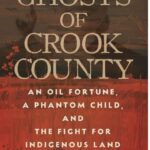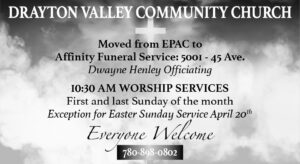Senior year is supposed to be a time for going out with friends, studying hard to get into your dream university or college and preparing yourself to say goodbye to teachers who have influenced your life over the past four years. For the class of 2021 though, it has been anything but that as they have found themselves in a constant back and forth from online learning to in school and barely any social outings. Here is a look at what a senior year in quarantine looked like to some of the grade 12 students of Drayton Valley and area.
Madison Prysko- Breton High School
Q: What has been the biggest struggle for you doing your senior year through Covid?
A: “I’m so accustomed to being able to see my family and all my friends. I’m a very social person so it’s very difficult to have to kind of reel that all back in and distance myself from my family which was the hardest.”
Q: Academically, how has Covid affected you this year?
A: “For online schooling I was okay. It was a bit of a struggle because we’ve always been very hands on learning with all of our teachers and it was very difficult between the teachers having to quarantine because of potential Covid cases and trying to figure everything out as it felt like in other years it was easier. This year was definitely harder and I do feel like most definitely I could have done better but with Covid it was extremely difficult.”
Q: Senior year usually involves tons of social events. How has Covid affected this?
A: “You see past years and they get to go out and party and celebrate amazing events in their life and we can’t this year.”
Q: Graduation will look a little different this year, what are your thoughts on it?
A: “I am disappointed but I do know that my principal as well as my grad representative is doing the best they can with what we can do. I’m extremely disappointed but there really is not much we can do about it.”
Q: What do your future plans look like?
A: “I’m hoping to take a gap year, kind of hoping for more vaccinations to be out and everything to kind of calm down Covid related before I do apply to school because I want the full education that I’m paying for with tuition and I wanna be able to be in classes learning. That’s the best way I learn instead of in a dorm room on my computer.”

All Saints Anglican Church
Drayton Valley, All Saints Anglican Church participates in the Anglican Liturgy, which comforts and sustains us. Many have said that in such a busy and changing world it is important to come to a place that feels like home.

B.D. Lock and Key Ltd.
Share on facebook Facebook Share on email Email Share on linkedin LinkedIn Share on whatsapp

Living Spirit United Church
Everyone welcome. Sunday Worship, 10:30 We are residents of Drayton Valley, members and adherents of

Valley Worship Assembly
Please take your time and discover what is happening at Valley Worship in Drayton Valley.

Ralcomm Communications
The Ralcomm Group provides communication devices for individuals and businesses. We specialize in technology that
Rae-Lynne MacDuff– Holy Trinity Academy
Q: What has been the biggest struggle for you doing your senior year through Covid?
A: “The social aspect I think, you do a lot of it on your own and not as much with your friends helping you through it… We even do things like parties through school that we haven’t been able to do. We haven’t gotten to do a lot of the activities we are used to or our big trip to the Citadel we take every year.”
Q: Academically, how has Covid affected you this year?
A: “I personally haven’t seen a drop in my grades but being at home has forced me to work harder.”
Q: Graduation will look a little different this year, what are your thoughts on it?
A: “I think we’ve put together a really fun event that’s just gonna celebrate the accomplishments we’ve achieved and we are happy with what we have I think.”
Q: What do your future plans look like?
A:“I’m going on to the University of Alberta to get a Bachelor of Elementary Education.”
Gwyneth Lizardo- Holy Trinity Academy
Q: What has been the biggest struggle for you doing your senior year through Covid?
A: “I think staying home and not seeing people for a long time. Not being able to see my friends and not being able to see my teachers that I was supposed to spend time with during my last year of school.”
Q: Academically, how has Covid affected you this year?
A: “I feel like Covid has not helped me at all. I learn better when I’m at school. Just trying to stay focused has been hard.”
Q: What do your future plans look like?
A: “I’m going to the University of Alberta and taking a Bachelor of Arts and Economics.”
An all Canadian team that included a local resident was able to win the rodeo for the first time in the history of the World Famous Miles City Bucking Horse Cowboy Mardi Gras.
Wilfred Titanich was one of a team of three that attended the three-day event in Miles City, Montana from May 15-18. Titanich along with two brothers, Cory and Cody Loken, were the first all Canadian team to win at Bucking Horse since the first Miles City Bucking Horse Sale started in 1951.
Each member of the team came home with around $7,500 US, says Titanich.
“We got Championship Buckles and we got Championship Holders, too,” he says.
The team participated in the Wild Horse Racing event, which involves at least three people and an untouched horse. The horse starts out in the bucking chute and two members of the team follow the horse out, holding onto a long lead. One person is the mugger, and their job is to control the horse’s head by covering its eyes with his arm, which calms it and prevents it from rearing and hurting someone. The shanker holds onto the rope so it doesn’t run away. The rider saddles it, mounts, and holds on tight as they race to the finish line on a wild horse.
“Wild Horse Racing is one of the oldest events in rodeo,” says Titanich.
Though the event is called Wild Horse Racing, the horses used in the event are owned, but untouched.
Throughout the year, Titanich works the Canadian Wild Horse Racing Association Circuit, spending most of his time in Alberta, but also attending some events in B.C. and Saskatchewan, where he competes in both amateur and pro rodeos.
“Honestly, it’s really addicting,” says Titanich. “It looks really crazy, and it is pretty wild, but it’s super addicting. It’s an adrenaline rush in sport.”
He says he would encourage people who like competitive events to try Wild Horse Racing.
The Loken brothers have both been in the sport for about 15 years, says Titanich. Both of them were about 14-years-old when they first started out. Titanich has been in the sport for three or four years.
Normally, the Lokens race with their dad, Jason, and Titanich has his own team. But the three of them thought it would be fun to head down to Miles City for some fun.
The Bucking Horse Sale was a stand-alone event, says Titanich. His team is getting ready for the circuit this summer.
“We can rodeo every weekend from now to the end of October,” he says.
Anyone looking for information about which wild horse racing rodeos are coming up can visit www.wildhorseracing.ca. Titanich says he will be in Brooks at the Lea Park Rodeo this weekend and in Killam for the Killam Rodeo that will be held outdoors in Sedgewick this year.
From Oklahoma to Keystone: Uncovering Hidden Histories at the Breton Library
An author who has written a non-fiction book that ties the Breton area to a mysterious child in Oklahoma will be visiting the Breton Library on June 7.
Russell Cobb, author of Ghosts of Crook County: An Oil Fortune, A Phantom Child, and the Fight for Indigenous Land is a Professor of Modern Languages and Cultural Studies at the University of Alberta. He was invited to the library by the Breton Library Board and the Breton Museum.
Allan Goddard, the manager of the Breton Museum, says he met Cobb when the author was working on the manuscript for the novel.
“He came out to the museum because there is a connection to the Hooks family,” he says.
Goddard says while the book does have some history about the Keystone area, and some relatives that may still live in the area, it is mainly about what indigenous families had to deal with in the early 1900s in Oklahoma.
Claire Sather, the Chair of the Board of Trustees for the Breton Library, says she read the book after finding it on Goodreads, a social media site dedicated to book ratings and reviews.
She says when she got to the end and saw a familiar name, Brandy Fredrickson, it really registered how close some events in the book are tied to the area.
Goddard says when Jim Crow laws came into being in Oklahoma, it triggered an exodus of African Americans from Oklahoma to seek out refuge in Canada. A group of those immigrants settled around Breton in the Keystone area in the early 1900s.
The book centres around a child named Tommy Atkins, whose existence has never truly been proven, and the oilmen who were snatching up indigenous lands in Oklahoma. Goddard says one of the women rumoured to be Atkins’ mother lived in Keystone for a while before returning to Oklahoma.
Both Sather and Goddard are excited to have him visit the Library, however, the space is limited. Those who wish to attend the event on Saturday, June 7th at 1 p.m. have to pre-register to ensure they get a spot.
Those who are interested can register by calling the library at 780-696-3740 or send an email to bretonlibrary@yrl.ab.ca.
Cobb has also written The Great Oklahoma Swindle: Race, Religions, and Lies in America’s Weirdest State.
VE Day at 80: How World War II Is Fading from Living Memory
Eighty years ago this week a group of men gathered in a room in Berlin to sign a piece of paper which brought an end to six years of war in Europe.
It was one of the most significant turning points of the last 1,000 years. It’s an event which will be remembered as well as any in the history of humanity. But history is very much what it is becoming.
World War II will never be forgotten, but it is rapidly becoming little more than a memory.
Anyone involved in the actual fighting would be, at the very least, in their mid-90s. Today the median age in Canada is somewhere around 40. That means the war belongs more to our grandparents’ generation than to our parents’. We’re now approaching the point where no one alive will remember World War II .
Sad as that may seem, it’s part of the inevitable ebb and flow of human events. Things move on. No one today mourns the 65,000 who died at the Battle of Waterloo or those who lost their lives at a thousand other places from Thermopylae to Gettysburg. Instead we are more likely to dress up as them and re enact the events of the day, for reasons that, I must confess, have never been entirely clear to me.
And so it will be with World War II. Certainly the events 25 years earlier at Ypres, the Somme and Passchendaele have now taken on a sepia tinge. They have gone from being a horrendous bloodbath to a historical curiosity.
Time moves on. It’s a natural process and not something we could reverse even if we wanted to.
Years ago I worked with a copy editor who would indignantly write “which one?” in the margins of any news story that simply referred to “the war.” At the time I thought he was a bit of a dickhead. But now, well, I’m still pretty sure he was a dickhead, but he may have been a dickhead with a point.
The world has been far from peaceful since May of 1945. For one thing, the war in Asia was still raging on this day in 1945 and would not end for a few more months with the fall of Japan. But, also this week in 1954 the French were defeated by the Vietnamese in the battle of Dien Bein Phu. This week in 1960 the Soviet Union announced it was holding American U2 pilot Gary Powers. This week in 1999 NATO accidentally bombed the Chinese Embassy in Kosovo. And if you checked the news this morning you probably saw that war continues in Ukraine. Tragedy is continuing to unfold in Gaza. And, well, you get the picture.
Still, by asking “which war” my former colleague may have been a little bit ahead of his time. When someone mentions “The War”most of us will immediately think of 1939-1945.
But time will prove my copy editor’s point. Events, even the most important events in the world, gradually fade into history.
It won’t happen overnight, but make no mistake, it will happen. The process is already under way.
Drayton Valley looks at rural wealth creation
In partnership with the University of Alberta’s Community University Partnership (CUP) town council will be looking at different ways that Drayton Valley residents can work to generate local wealth for the community.
Geraldine Cahill, the director of UpSocial Canada who works with CUP, along with Dr. Maria Mayan from the U of A, spoke to council about initiatives that other municipalities have taken on to help stimulate local economies.
CUP has been working in Drayton Valley since 2020, when they helped the Town develop the Zero Fee Tuition Program, now called the Tuition Assistance Bursary. The partnership was developed for a research project to explore whether the ZFT program could be a mechanism for an inclusive economy.
“The results so far have been very positive, both on employment and also for quality of life for participants,” said Cahill.
Cahill told council they had engaged with stakeholders during the research and found a strategy that they would like to explore with the Town. They believe that Rural Wealth Creation could be an effective initiative to help Drayton Valley navigate increased costs in a way that can benefit the entire community.
“Across the country there has been a pattern of downloading costs and responsibilities to municipalities… without much change in capital transfers,” said Cahill. “That puts a great deal of strain on municipal governments and single-resource towns have been hard hit by this.”
With RWC, the Town would work together with residents to develop ways that residents can invest in community projects as part of their retirement, thus ensuring a larger chunk of local money stays in the municipality.
Over the past few years communities across the country have achieved economic stability by using programs such as co-operatives, local procurement, employee ownership and other succession models, community bonds, community land trusts and more. Cahill also provided examples from some of the municipalities that have gone in this direction.
In 2002, the municipality of Westlock learned that their grain terminals were going to be sold. As agriculture was one of the important sectors for the community, there was concern about how the sale could affect the local economy. So, instead of letting the grain terminals go, the community worked together to raise $1.2 million to purchase the grain terminal.
Those who invested in the terminal now get yearly dividends for their investment. They also have the most profitable terminal for its size in Canada and are planning on diversifying into a transport company.
Cahill says that the size of the municipality may play a role in which type of community program would work best.
Mayor Nancy Dodds asked Cahill how the Town could move forward with the plan as they would have to play a role in whatever path residents choose to move forward with.
“As the Town, as leaders, we want to be involved, but we don’t want to be getting in the way,” said Dodds. “How do you make sure that everyone has their say when you’re picking that.”
CUP has a workshop planned for May 5 at Clean Energy Technology Centre to help brainstorm some ideas that may work in the community. Cahill says everyone is welcome to attend and they will be looking at community assets as well as asking attendees what their priorities are.
Cahill says once they get some feedback from the meeting, she can use those priorities and ideas to generate profiles of which programs could best address them and how it would affect the community.
“Then we can shop them around for several months,” says Cahill. “I don’t want to rush the process so that people have a chance to weigh in.”
60 years strong: St. Anthony School plans celebration and future growth
In January 1965, the St. Anthony School opened its doors. Now, 60 years later, the school is planning a celebration of the milestone.
Principal Janelle Molzan says they are planning to have a celebration on May 24 at the school gym. They will be using the event to also fundraise for the school.
Molzan says they will have a band performing that evening, catering from a local restaurant, a full cash bar, as well as some door prizes.
Part of the celebration will also be the fact that St. Thomas Aquinas Roman Catholic School Division has put St. Anthony at the top of their priority list for a new school. Molzan says the division has to wait until next year to submit their request to the Province, and there is no guarantee that they will be selected for funding.
“It could be anywhere from two to ten years,” she says. “Or more.”
However, she feels that St. Anthony has a strong case for asking for a new school.
The most recent remodel of the school was in 1992, says Molzan. At that point they expanded the school, removing the gym from the centre of the school and installing classrooms instead. The new gym was then built as an addition to the school.
“We had the addition of the gym as well as a few classrooms in 1992,” says Molzan.
Since then, there have been no major remodels or renovations. Instead, the staff have been doing what they can to keep the building in shape.
“It’s a really well built school,” says Molzan.
She says over the years, the natural heaves and settling that occur with temperature fluctuations has led to some cosmetic damages to the building. “It’s just showing its age,” she says.
While the school is starting to show wear, Molzan says there are no capacity issues. About 15 years ago, the school went from being a K-12 school to a K-8 school when the Holy Trinity Academy was built.
Molzan says if they don’t get a new school they will have to pursue getting more renovations or remodeling for the current building.
New trespassing program helps businesses
Businesses will now have another option for dealing with trespassers thanks to a new program that Enforcement Services have put into place.
Cody Rossing, the manager of enforcement services and emergency management for the Town, says one of the biggest challenges for businesses in the community who were issuing trespass notices is that someone has to attend court in order for the trespassing charge to stick. With the new Trespassing Agent program which comes into place on March 20, businesses who enrol will not have to attend court.
Previously, businesses who contacted the RCMP to report a trespasser had to issue the trespass notices themselves.
For many businesses the process didn’t work well. Larger franchises, like banks, found arranging the issue of a trespass notice and attending court was not logistically feasible. Small business owners, on the other hand, could issue the notice but may have to close their business in order to attend court.
Rossing says there are two different pieces of legislation that speak to trespassing, the Petty Trespass Act and the Trespass to Premises Act.
“Under both of the legislations, the property owner or their agent are required to provide trespass notices, help get people off of their land, and stuff like that,” says Rossing.
The first offence fine under the provincial legislation is normally $600, but it could be up to $10,000. A second offence could have a fine of up to $25,000
The higher fines come into place when the individual ignores the notice and returns to the property. If the trespasser returns three times, the officers can then issue a summons to court. If they fail to attend, a warrant is issued, and at that point if they are found guilty, the higher fines can be given.
Rossing says the program is helping streamline the process for businesses. If they choose to enrol in the program, it will allow peace officers or the RCMP to act as their agent and issue the notices. It also means the business owners won’t have to attend court.
“Court is scary for a lot of people, and we understand that,” says Rossing.
The purpose of the program is to improve the process because officers are continuing to get calls to the same place over and over and business owners or their employees are uncomfortable with the court process. Until now, there hasn’t been any way to address those issues.
“It’s been a lot of work on the back end because there is no follow up process in place and there is no trespass notice being issued,” says Rossing.
He says the hope is that by having this program in place, businesses can sign up and they can begin to address the issue more efficiently.
Several different municipalities in the province have a similar program in place, says Rossing. While developing the program, Rossing did research on other initiatives and reached out to other municipalities that had something similar in place. He says he wanted to be sure that he had everything in place before he announced the program in the community.
There are also checks and balances that have been worked into the program.
“If you’re trespassed from a local business, one of our officers shows up and says you’re trespassed for six months, if you don’t agree with it, you can appeal that process,” says Rossing.
He says there is also the option for the business owners to speak with the officer and reduce the amount of time the individual is trespassed for. In some cases, if the RCMP issue a notice that’s in effect for six months, a business owner may come forward and advocate for the trespasser if the individual doesn’t normally behave in that manner
“They can say, ‘This person is normally a good customer, but there is something going on with him right now. I think maybe a month would be more appropriate,’” says Rossing.
However, it is ultimately the final discretion of the officer.
Once a business is enrolled in the program, they will receive a sticker that they can place in a conspicuous area that is easily visible for officers. If they receive a call, the officer will know that they can issue the notice themselves rather than speaking to the owner and explaining the process that has to take place.
Rossing says enrolment in the program is free, and he encourages businesses to sign up if they are having consistent issues with people loitering or being a nuisance on their property. Those who are interested in enrolling can visit www.draytonvalley.ca/enforcementservices/trespassingagent and fill out the form. They can then email it in to enforcement@draytonvalley.ca or drop it off at the Town office.
Mathea Cruickshank- Holy Trinity Academy
Q: What has been the biggest struggle for you doing your senior year through Covid?
A: “It’s been hard building up self motivation, now you have to do stuff on your own and not have a support system there to help you out with schooling or any other aspects that you’d usually have in a regular year.”
Q: Academically, how has Covid affected you this year?
A: “I got relatively the same grades but definitely classes that I’m not as good at or passionate about my grades definitely dropped. I didn’t have the motivation to get stuff done.”
Q: Senior year usually involves tons of social events. How has Covid affected this?
A: “I feel like missing out on parties and just stuff like that. We didn’t get to create as strong of a class bond this year as other classes. Even just like sports teams and stuff we didn’t get to get together and have that type of fun.”
Q: Graduation will look a little different this year, what are your thoughts on it?
A: “I almost kind of like this year better because they are making us feel really special and I know not a lot of graduates get to experience what we are experiencing so I’m thankful for what we have.”
Q: What do your future plans look like?
A: “I’m going to Mount Royal University for a degree in social work.”
Rebekah Pequin- Holy Trinity Academy
Q: What has been the biggest struggle for you doing your senior year through Covid?
A: “Caring about school. It’s been difficult to have a positive attitude and the motivation to get the work done when you don’t have the encouragement from teachers and friends and not having a routine.”
Q: Academically, how has Covid affected you this year?
A: “It’s been a bit of a struggle but I’d say it’s more difficult to get the help. If you are struggling with something it’s harder to have the one on one that HTA normally has.”
Q: Senior year usually involves tons of social events. How has Covid affected this?
A: “I definitely missed out on sports. It was my last year to play basketball and to be the captain and all that. We didn’t get any of that this year. The tournaments are a big part of it but the bonding aspect also with your couches and with your teammates.”
Q: Graduation will look a little different this year, what are your thoughts on it?
A: “I’m excited that it’s something different but it’s also disappointing that I saw both my older brothers’ grads and it was a lot of fun and it was a lot of togetherness with all the teachers, all the staff and kids you aren’t as close with in your class you become closer with at the banquet… We definitely won’t be able to get that and I definitely won’t be able to have my family see me work on my accomplishments because a lot of them won’t come if it’s just in a car.”
Q: What do your future plans look like?
A: I’m attending Grant Macewan for a Bachelor of Arts in psychology to do a career as a prison psychologist.
An all Canadian team that included a local resident was able to win the rodeo for the first time in the history of the World Famous Miles City Bucking Horse Cowboy Mardi Gras.
Wilfred Titanich was one of a team of three that attended the three-day event in Miles City, Montana from May 15-18. Titanich along with two brothers, Cory and Cody Loken, were the first all Canadian team to win at Bucking Horse since the first Miles City Bucking Horse Sale started in 1951.
Each member of the team came home with around $7,500 US, says Titanich.
“We got Championship Buckles and we got Championship Holders, too,” he says.
The team participated in the Wild Horse Racing event, which involves at least three people and an untouched horse. The horse starts out in the bucking chute and two members of the team follow the horse out, holding onto a long lead. One person is the mugger, and their job is to control the horse’s head by covering its eyes with his arm, which calms it and prevents it from rearing and hurting someone. The shanker holds onto the rope so it doesn’t run away. The rider saddles it, mounts, and holds on tight as they race to the finish line on a wild horse.
“Wild Horse Racing is one of the oldest events in rodeo,” says Titanich.
Though the event is called Wild Horse Racing, the horses used in the event are owned, but untouched.
Throughout the year, Titanich works the Canadian Wild Horse Racing Association Circuit, spending most of his time in Alberta, but also attending some events in B.C. and Saskatchewan, where he competes in both amateur and pro rodeos.
“Honestly, it’s really addicting,” says Titanich. “It looks really crazy, and it is pretty wild, but it’s super addicting. It’s an adrenaline rush in sport.”
He says he would encourage people who like competitive events to try Wild Horse Racing.
The Loken brothers have both been in the sport for about 15 years, says Titanich. Both of them were about 14-years-old when they first started out. Titanich has been in the sport for three or four years.
Normally, the Lokens race with their dad, Jason, and Titanich has his own team. But the three of them thought it would be fun to head down to Miles City for some fun.
The Bucking Horse Sale was a stand-alone event, says Titanich. His team is getting ready for the circuit this summer.
“We can rodeo every weekend from now to the end of October,” he says.
Anyone looking for information about which wild horse racing rodeos are coming up can visit www.wildhorseracing.ca. Titanich says he will be in Brooks at the Lea Park Rodeo this weekend and in Killam for the Killam Rodeo that will be held outdoors in Sedgewick this year.
An author who has written a non-fiction book that ties the Breton area to a mysterious child in Oklahoma will be visiting the Breton Library on June 7.
Russell Cobb, author of Ghosts of Crook County: An Oil Fortune, A Phantom Child, and the Fight for Indigenous Land is a Professor of Modern Languages and Cultural Studies at the University of Alberta. He was invited to the library by the Breton Library Board and the Breton Museum.
Allan Goddard, the manager of the Breton Museum, says he met Cobb when the author was working on the manuscript for the novel.
“He came out to the museum because there is a connection to the Hooks family,” he says.
Goddard says while the book does have some history about the Keystone area, and some relatives that may still live in the area, it is mainly about what indigenous families had to deal with in the early 1900s in Oklahoma.
Claire Sather, the Chair of the Board of Trustees for the Breton Library, says she read the book after finding it on Goodreads, a social media site dedicated to book ratings and reviews.
She says when she got to the end and saw a familiar name, Brandy Fredrickson, it really registered how close some events in the book are tied to the area.
Goddard says when Jim Crow laws came into being in Oklahoma, it triggered an exodus of African Americans from Oklahoma to seek out refuge in Canada. A group of those immigrants settled around Breton in the Keystone area in the early 1900s.
The book centres around a child named Tommy Atkins, whose existence has never truly been proven, and the oilmen who were snatching up indigenous lands in Oklahoma. Goddard says one of the women rumoured to be Atkins’ mother lived in Keystone for a while before returning to Oklahoma.
Both Sather and Goddard are excited to have him visit the Library, however, the space is limited. Those who wish to attend the event on Saturday, June 7th at 1 p.m. have to pre-register to ensure they get a spot.
Those who are interested can register by calling the library at 780-696-3740 or send an email to bretonlibrary@yrl.ab.ca.
Cobb has also written The Great Oklahoma Swindle: Race, Religions, and Lies in America’s Weirdest State.
Eighty years ago this week a group of men gathered in a room in Berlin to sign a piece of paper which brought an end to six years of war in Europe.
It was one of the most significant turning points of the last 1,000 years. It’s an event which will be remembered as well as any in the history of humanity. But history is very much what it is becoming.
World War II will never be forgotten, but it is rapidly becoming little more than a memory.
Anyone involved in the actual fighting would be, at the very least, in their mid-90s. Today the median age in Canada is somewhere around 40. That means the war belongs more to our grandparents’ generation than to our parents’. We’re now approaching the point where no one alive will remember World War II .
Sad as that may seem, it’s part of the inevitable ebb and flow of human events. Things move on. No one today mourns the 65,000 who died at the Battle of Waterloo or those who lost their lives at a thousand other places from Thermopylae to Gettysburg. Instead we are more likely to dress up as them and re enact the events of the day, for reasons that, I must confess, have never been entirely clear to me.
And so it will be with World War II. Certainly the events 25 years earlier at Ypres, the Somme and Passchendaele have now taken on a sepia tinge. They have gone from being a horrendous bloodbath to a historical curiosity.
Time moves on. It’s a natural process and not something we could reverse even if we wanted to.
Years ago I worked with a copy editor who would indignantly write “which one?” in the margins of any news story that simply referred to “the war.” At the time I thought he was a bit of a dickhead. But now, well, I’m still pretty sure he was a dickhead, but he may have been a dickhead with a point.
The world has been far from peaceful since May of 1945. For one thing, the war in Asia was still raging on this day in 1945 and would not end for a few more months with the fall of Japan. But, also this week in 1954 the French were defeated by the Vietnamese in the battle of Dien Bein Phu. This week in 1960 the Soviet Union announced it was holding American U2 pilot Gary Powers. This week in 1999 NATO accidentally bombed the Chinese Embassy in Kosovo. And if you checked the news this morning you probably saw that war continues in Ukraine. Tragedy is continuing to unfold in Gaza. And, well, you get the picture.
Still, by asking “which war” my former colleague may have been a little bit ahead of his time. When someone mentions “The War”most of us will immediately think of 1939-1945.
But time will prove my copy editor’s point. Events, even the most important events in the world, gradually fade into history.
It won’t happen overnight, but make no mistake, it will happen. The process is already under way.
In partnership with the University of Alberta’s Community University Partnership (CUP) town council will be looking at different ways that Drayton Valley residents can work to generate local wealth for the community.
Geraldine Cahill, the director of UpSocial Canada who works with CUP, along with Dr. Maria Mayan from the U of A, spoke to council about initiatives that other municipalities have taken on to help stimulate local economies.
CUP has been working in Drayton Valley since 2020, when they helped the Town develop the Zero Fee Tuition Program, now called the Tuition Assistance Bursary. The partnership was developed for a research project to explore whether the ZFT program could be a mechanism for an inclusive economy.
“The results so far have been very positive, both on employment and also for quality of life for participants,” said Cahill.
Cahill told council they had engaged with stakeholders during the research and found a strategy that they would like to explore with the Town. They believe that Rural Wealth Creation could be an effective initiative to help Drayton Valley navigate increased costs in a way that can benefit the entire community.
“Across the country there has been a pattern of downloading costs and responsibilities to municipalities… without much change in capital transfers,” said Cahill. “That puts a great deal of strain on municipal governments and single-resource towns have been hard hit by this.”
With RWC, the Town would work together with residents to develop ways that residents can invest in community projects as part of their retirement, thus ensuring a larger chunk of local money stays in the municipality.
Over the past few years communities across the country have achieved economic stability by using programs such as co-operatives, local procurement, employee ownership and other succession models, community bonds, community land trusts and more. Cahill also provided examples from some of the municipalities that have gone in this direction.
In 2002, the municipality of Westlock learned that their grain terminals were going to be sold. As agriculture was one of the important sectors for the community, there was concern about how the sale could affect the local economy. So, instead of letting the grain terminals go, the community worked together to raise $1.2 million to purchase the grain terminal.
Those who invested in the terminal now get yearly dividends for their investment. They also have the most profitable terminal for its size in Canada and are planning on diversifying into a transport company.
Cahill says that the size of the municipality may play a role in which type of community program would work best.
Mayor Nancy Dodds asked Cahill how the Town could move forward with the plan as they would have to play a role in whatever path residents choose to move forward with.
“As the Town, as leaders, we want to be involved, but we don’t want to be getting in the way,” said Dodds. “How do you make sure that everyone has their say when you’re picking that.”
CUP has a workshop planned for May 5 at Clean Energy Technology Centre to help brainstorm some ideas that may work in the community. Cahill says everyone is welcome to attend and they will be looking at community assets as well as asking attendees what their priorities are.
Cahill says once they get some feedback from the meeting, she can use those priorities and ideas to generate profiles of which programs could best address them and how it would affect the community.
“Then we can shop them around for several months,” says Cahill. “I don’t want to rush the process so that people have a chance to weigh in.”
In January 1965, the St. Anthony School opened its doors. Now, 60 years later, the school is planning a celebration of the milestone.
Principal Janelle Molzan says they are planning to have a celebration on May 24 at the school gym. They will be using the event to also fundraise for the school.
Molzan says they will have a band performing that evening, catering from a local restaurant, a full cash bar, as well as some door prizes.
Part of the celebration will also be the fact that St. Thomas Aquinas Roman Catholic School Division has put St. Anthony at the top of their priority list for a new school. Molzan says the division has to wait until next year to submit their request to the Province, and there is no guarantee that they will be selected for funding.
“It could be anywhere from two to ten years,” she says. “Or more.”
However, she feels that St. Anthony has a strong case for asking for a new school.
The most recent remodel of the school was in 1992, says Molzan. At that point they expanded the school, removing the gym from the centre of the school and installing classrooms instead. The new gym was then built as an addition to the school.
“We had the addition of the gym as well as a few classrooms in 1992,” says Molzan.
Since then, there have been no major remodels or renovations. Instead, the staff have been doing what they can to keep the building in shape.
“It’s a really well built school,” says Molzan.
She says over the years, the natural heaves and settling that occur with temperature fluctuations has led to some cosmetic damages to the building. “It’s just showing its age,” she says.
While the school is starting to show wear, Molzan says there are no capacity issues. About 15 years ago, the school went from being a K-12 school to a K-8 school when the Holy Trinity Academy was built.
Molzan says if they don’t get a new school they will have to pursue getting more renovations or remodeling for the current building.
Businesses will now have another option for dealing with trespassers thanks to a new program that Enforcement Services have put into place.
Cody Rossing, the manager of enforcement services and emergency management for the Town, says one of the biggest challenges for businesses in the community who were issuing trespass notices is that someone has to attend court in order for the trespassing charge to stick. With the new Trespassing Agent program which comes into place on March 20, businesses who enrol will not have to attend court.
Previously, businesses who contacted the RCMP to report a trespasser had to issue the trespass notices themselves.
For many businesses the process didn’t work well. Larger franchises, like banks, found arranging the issue of a trespass notice and attending court was not logistically feasible. Small business owners, on the other hand, could issue the notice but may have to close their business in order to attend court.
Rossing says there are two different pieces of legislation that speak to trespassing, the Petty Trespass Act and the Trespass to Premises Act.
“Under both of the legislations, the property owner or their agent are required to provide trespass notices, help get people off of their land, and stuff like that,” says Rossing.
The first offence fine under the provincial legislation is normally $600, but it could be up to $10,000. A second offence could have a fine of up to $25,000
The higher fines come into place when the individual ignores the notice and returns to the property. If the trespasser returns three times, the officers can then issue a summons to court. If they fail to attend, a warrant is issued, and at that point if they are found guilty, the higher fines can be given.
Rossing says the program is helping streamline the process for businesses. If they choose to enrol in the program, it will allow peace officers or the RCMP to act as their agent and issue the notices. It also means the business owners won’t have to attend court.
“Court is scary for a lot of people, and we understand that,” says Rossing.
The purpose of the program is to improve the process because officers are continuing to get calls to the same place over and over and business owners or their employees are uncomfortable with the court process. Until now, there hasn’t been any way to address those issues.
“It’s been a lot of work on the back end because there is no follow up process in place and there is no trespass notice being issued,” says Rossing.
He says the hope is that by having this program in place, businesses can sign up and they can begin to address the issue more efficiently.
Several different municipalities in the province have a similar program in place, says Rossing. While developing the program, Rossing did research on other initiatives and reached out to other municipalities that had something similar in place. He says he wanted to be sure that he had everything in place before he announced the program in the community.
There are also checks and balances that have been worked into the program.
“If you’re trespassed from a local business, one of our officers shows up and says you’re trespassed for six months, if you don’t agree with it, you can appeal that process,” says Rossing.
He says there is also the option for the business owners to speak with the officer and reduce the amount of time the individual is trespassed for. In some cases, if the RCMP issue a notice that’s in effect for six months, a business owner may come forward and advocate for the trespasser if the individual doesn’t normally behave in that manner
“They can say, ‘This person is normally a good customer, but there is something going on with him right now. I think maybe a month would be more appropriate,’” says Rossing.
However, it is ultimately the final discretion of the officer.
Once a business is enrolled in the program, they will receive a sticker that they can place in a conspicuous area that is easily visible for officers. If they receive a call, the officer will know that they can issue the notice themselves rather than speaking to the owner and explaining the process that has to take place.
Rossing says enrolment in the program is free, and he encourages businesses to sign up if they are having consistent issues with people loitering or being a nuisance on their property. Those who are interested in enrolling can visit www.draytonvalley.ca/enforcementservices/trespassingagent and fill out the form. They can then email it in to enforcement@draytonvalley.ca or drop it off at the Town office.
Corbyn Colwell- Frank Maddock High School
Q: What has been the biggest struggle for you doing your senior year through Covid?
A: “Motivation. Just having a hard time keeping up with school because we keep going in and out of it. So the learning styles are different even.”
Q: Academically, how has Covid affected you this year?
A: “I’m pretty sure there has been a drop but there are some classes where the work has somehow gotten easier… I noticed with a lot of my friends that we focus on one subject more than the others during online school so we get behind so our grades all fluctuate due to that.”
Q: Senior year usually involves tons of social events. How has Covid affected this?
A: “I feel like I don’t know most of my class as much as the previous classes have but I have gotten closer to the people who are actually in my classes.”
Q: Graduation will look a little different this year, what are your thoughts on it?
A: “I’m liking how it’s gonna be outside and a little bit quieter than it usually is but I am a little disappointed that there’s a possibility that we won’t get a prom.”
Q: What do your future plans look like?
A: “My plan is to work for a year and try to figure out what I wanna do. And then I’m going to go to school.”
Delaina Osborne– Frank Maddock High School
Q: What has been the biggest struggle for you doing your senior year through Covid?
A: “Definitely motivation and burnout… Because I’m so academically orientated I have to get really high grades to feel successful so to have to combat going from in person learning to at home learning was very stressful and then very unmotivating because have the time we would be doing things and then all the sudden they wouldn’t matter anymore and so after first semester my burnout hit really really hard and so it made things very difficult to see the point of continuing.”
Q: Senior year usually involves tons of social events. How has Covid affected this?
A: “Because we are seniors we expect that this year is to be all about our graduation and all about our success so we want to go out and we want to go to Edmonton on the weekends, we want to go swimming, we want to hang out and stuff and we haven’t had the ability to do that and actually be able to celebrate us as like this transition period in our lives… So I think socially it was very detrimental and a lot of people did suffer from that whether that be just they are very extroverted or just the fact that they felt like they weren’t mattering anymore.”
Q: Graduation will look a little different this year, what are your thoughts on it?
A: “The school is doing a lot with what they have… I’m hoping that with restrictions opening up hopefully early July then myself and others can celebrate. It just sucks that we won’t be around our teachers and we won’t be around the families who have supported us through all this. So we won’t be able to cross the stage and say hey I did this to everyone. It will just be myself, two other teachers and my parents.”
Q: What do your future plans look like?
A: “I am going to the University of Alberta for an English major and an art minor because I plan on applying myself to more of the arts in my future.”
An all Canadian team that included a local resident was able to win the rodeo for the first time in the history of the World Famous Miles City Bucking Horse Cowboy Mardi Gras.
Wilfred Titanich was one of a team of three that attended the three-day event in Miles City, Montana from May 15-18. Titanich along with two brothers, Cory and Cody Loken, were the first all Canadian team to win at Bucking Horse since the first Miles City Bucking Horse Sale started in 1951.
Each member of the team came home with around $7,500 US, says Titanich.
“We got Championship Buckles and we got Championship Holders, too,” he says.
The team participated in the Wild Horse Racing event, which involves at least three people and an untouched horse. The horse starts out in the bucking chute and two members of the team follow the horse out, holding onto a long lead. One person is the mugger, and their job is to control the horse’s head by covering its eyes with his arm, which calms it and prevents it from rearing and hurting someone. The shanker holds onto the rope so it doesn’t run away. The rider saddles it, mounts, and holds on tight as they race to the finish line on a wild horse.
“Wild Horse Racing is one of the oldest events in rodeo,” says Titanich.
Though the event is called Wild Horse Racing, the horses used in the event are owned, but untouched.
Throughout the year, Titanich works the Canadian Wild Horse Racing Association Circuit, spending most of his time in Alberta, but also attending some events in B.C. and Saskatchewan, where he competes in both amateur and pro rodeos.
“Honestly, it’s really addicting,” says Titanich. “It looks really crazy, and it is pretty wild, but it’s super addicting. It’s an adrenaline rush in sport.”
He says he would encourage people who like competitive events to try Wild Horse Racing.
The Loken brothers have both been in the sport for about 15 years, says Titanich. Both of them were about 14-years-old when they first started out. Titanich has been in the sport for three or four years.
Normally, the Lokens race with their dad, Jason, and Titanich has his own team. But the three of them thought it would be fun to head down to Miles City for some fun.
The Bucking Horse Sale was a stand-alone event, says Titanich. His team is getting ready for the circuit this summer.
“We can rodeo every weekend from now to the end of October,” he says.
Anyone looking for information about which wild horse racing rodeos are coming up can visit www.wildhorseracing.ca. Titanich says he will be in Brooks at the Lea Park Rodeo this weekend and in Killam for the Killam Rodeo that will be held outdoors in Sedgewick this year.
An author who has written a non-fiction book that ties the Breton area to a mysterious child in Oklahoma will be visiting the Breton Library on June 7.
Russell Cobb, author of Ghosts of Crook County: An Oil Fortune, A Phantom Child, and the Fight for Indigenous Land is a Professor of Modern Languages and Cultural Studies at the University of Alberta. He was invited to the library by the Breton Library Board and the Breton Museum.
Allan Goddard, the manager of the Breton Museum, says he met Cobb when the author was working on the manuscript for the novel.
“He came out to the museum because there is a connection to the Hooks family,” he says.
Goddard says while the book does have some history about the Keystone area, and some relatives that may still live in the area, it is mainly about what indigenous families had to deal with in the early 1900s in Oklahoma.
Claire Sather, the Chair of the Board of Trustees for the Breton Library, says she read the book after finding it on Goodreads, a social media site dedicated to book ratings and reviews.
She says when she got to the end and saw a familiar name, Brandy Fredrickson, it really registered how close some events in the book are tied to the area.
Goddard says when Jim Crow laws came into being in Oklahoma, it triggered an exodus of African Americans from Oklahoma to seek out refuge in Canada. A group of those immigrants settled around Breton in the Keystone area in the early 1900s.
The book centres around a child named Tommy Atkins, whose existence has never truly been proven, and the oilmen who were snatching up indigenous lands in Oklahoma. Goddard says one of the women rumoured to be Atkins’ mother lived in Keystone for a while before returning to Oklahoma.
Both Sather and Goddard are excited to have him visit the Library, however, the space is limited. Those who wish to attend the event on Saturday, June 7th at 1 p.m. have to pre-register to ensure they get a spot.
Those who are interested can register by calling the library at 780-696-3740 or send an email to bretonlibrary@yrl.ab.ca.
Cobb has also written The Great Oklahoma Swindle: Race, Religions, and Lies in America’s Weirdest State.
Eighty years ago this week a group of men gathered in a room in Berlin to sign a piece of paper which brought an end to six years of war in Europe.
It was one of the most significant turning points of the last 1,000 years. It’s an event which will be remembered as well as any in the history of humanity. But history is very much what it is becoming.
World War II will never be forgotten, but it is rapidly becoming little more than a memory.
Anyone involved in the actual fighting would be, at the very least, in their mid-90s. Today the median age in Canada is somewhere around 40. That means the war belongs more to our grandparents’ generation than to our parents’. We’re now approaching the point where no one alive will remember World War II .
Sad as that may seem, it’s part of the inevitable ebb and flow of human events. Things move on. No one today mourns the 65,000 who died at the Battle of Waterloo or those who lost their lives at a thousand other places from Thermopylae to Gettysburg. Instead we are more likely to dress up as them and re enact the events of the day, for reasons that, I must confess, have never been entirely clear to me.
And so it will be with World War II. Certainly the events 25 years earlier at Ypres, the Somme and Passchendaele have now taken on a sepia tinge. They have gone from being a horrendous bloodbath to a historical curiosity.
Time moves on. It’s a natural process and not something we could reverse even if we wanted to.
Years ago I worked with a copy editor who would indignantly write “which one?” in the margins of any news story that simply referred to “the war.” At the time I thought he was a bit of a dickhead. But now, well, I’m still pretty sure he was a dickhead, but he may have been a dickhead with a point.
The world has been far from peaceful since May of 1945. For one thing, the war in Asia was still raging on this day in 1945 and would not end for a few more months with the fall of Japan. But, also this week in 1954 the French were defeated by the Vietnamese in the battle of Dien Bein Phu. This week in 1960 the Soviet Union announced it was holding American U2 pilot Gary Powers. This week in 1999 NATO accidentally bombed the Chinese Embassy in Kosovo. And if you checked the news this morning you probably saw that war continues in Ukraine. Tragedy is continuing to unfold in Gaza. And, well, you get the picture.
Still, by asking “which war” my former colleague may have been a little bit ahead of his time. When someone mentions “The War”most of us will immediately think of 1939-1945.
But time will prove my copy editor’s point. Events, even the most important events in the world, gradually fade into history.
It won’t happen overnight, but make no mistake, it will happen. The process is already under way.
In partnership with the University of Alberta’s Community University Partnership (CUP) town council will be looking at different ways that Drayton Valley residents can work to generate local wealth for the community.
Geraldine Cahill, the director of UpSocial Canada who works with CUP, along with Dr. Maria Mayan from the U of A, spoke to council about initiatives that other municipalities have taken on to help stimulate local economies.
CUP has been working in Drayton Valley since 2020, when they helped the Town develop the Zero Fee Tuition Program, now called the Tuition Assistance Bursary. The partnership was developed for a research project to explore whether the ZFT program could be a mechanism for an inclusive economy.
“The results so far have been very positive, both on employment and also for quality of life for participants,” said Cahill.
Cahill told council they had engaged with stakeholders during the research and found a strategy that they would like to explore with the Town. They believe that Rural Wealth Creation could be an effective initiative to help Drayton Valley navigate increased costs in a way that can benefit the entire community.
“Across the country there has been a pattern of downloading costs and responsibilities to municipalities… without much change in capital transfers,” said Cahill. “That puts a great deal of strain on municipal governments and single-resource towns have been hard hit by this.”
With RWC, the Town would work together with residents to develop ways that residents can invest in community projects as part of their retirement, thus ensuring a larger chunk of local money stays in the municipality.
Over the past few years communities across the country have achieved economic stability by using programs such as co-operatives, local procurement, employee ownership and other succession models, community bonds, community land trusts and more. Cahill also provided examples from some of the municipalities that have gone in this direction.
In 2002, the municipality of Westlock learned that their grain terminals were going to be sold. As agriculture was one of the important sectors for the community, there was concern about how the sale could affect the local economy. So, instead of letting the grain terminals go, the community worked together to raise $1.2 million to purchase the grain terminal.
Those who invested in the terminal now get yearly dividends for their investment. They also have the most profitable terminal for its size in Canada and are planning on diversifying into a transport company.
Cahill says that the size of the municipality may play a role in which type of community program would work best.
Mayor Nancy Dodds asked Cahill how the Town could move forward with the plan as they would have to play a role in whatever path residents choose to move forward with.
“As the Town, as leaders, we want to be involved, but we don’t want to be getting in the way,” said Dodds. “How do you make sure that everyone has their say when you’re picking that.”
CUP has a workshop planned for May 5 at Clean Energy Technology Centre to help brainstorm some ideas that may work in the community. Cahill says everyone is welcome to attend and they will be looking at community assets as well as asking attendees what their priorities are.
Cahill says once they get some feedback from the meeting, she can use those priorities and ideas to generate profiles of which programs could best address them and how it would affect the community.
“Then we can shop them around for several months,” says Cahill. “I don’t want to rush the process so that people have a chance to weigh in.”
In January 1965, the St. Anthony School opened its doors. Now, 60 years later, the school is planning a celebration of the milestone.
Principal Janelle Molzan says they are planning to have a celebration on May 24 at the school gym. They will be using the event to also fundraise for the school.
Molzan says they will have a band performing that evening, catering from a local restaurant, a full cash bar, as well as some door prizes.
Part of the celebration will also be the fact that St. Thomas Aquinas Roman Catholic School Division has put St. Anthony at the top of their priority list for a new school. Molzan says the division has to wait until next year to submit their request to the Province, and there is no guarantee that they will be selected for funding.
“It could be anywhere from two to ten years,” she says. “Or more.”
However, she feels that St. Anthony has a strong case for asking for a new school.
The most recent remodel of the school was in 1992, says Molzan. At that point they expanded the school, removing the gym from the centre of the school and installing classrooms instead. The new gym was then built as an addition to the school.
“We had the addition of the gym as well as a few classrooms in 1992,” says Molzan.
Since then, there have been no major remodels or renovations. Instead, the staff have been doing what they can to keep the building in shape.
“It’s a really well built school,” says Molzan.
She says over the years, the natural heaves and settling that occur with temperature fluctuations has led to some cosmetic damages to the building. “It’s just showing its age,” she says.
While the school is starting to show wear, Molzan says there are no capacity issues. About 15 years ago, the school went from being a K-12 school to a K-8 school when the Holy Trinity Academy was built.
Molzan says if they don’t get a new school they will have to pursue getting more renovations or remodeling for the current building.
Businesses will now have another option for dealing with trespassers thanks to a new program that Enforcement Services have put into place.
Cody Rossing, the manager of enforcement services and emergency management for the Town, says one of the biggest challenges for businesses in the community who were issuing trespass notices is that someone has to attend court in order for the trespassing charge to stick. With the new Trespassing Agent program which comes into place on March 20, businesses who enrol will not have to attend court.
Previously, businesses who contacted the RCMP to report a trespasser had to issue the trespass notices themselves.
For many businesses the process didn’t work well. Larger franchises, like banks, found arranging the issue of a trespass notice and attending court was not logistically feasible. Small business owners, on the other hand, could issue the notice but may have to close their business in order to attend court.
Rossing says there are two different pieces of legislation that speak to trespassing, the Petty Trespass Act and the Trespass to Premises Act.
“Under both of the legislations, the property owner or their agent are required to provide trespass notices, help get people off of their land, and stuff like that,” says Rossing.
The first offence fine under the provincial legislation is normally $600, but it could be up to $10,000. A second offence could have a fine of up to $25,000
The higher fines come into place when the individual ignores the notice and returns to the property. If the trespasser returns three times, the officers can then issue a summons to court. If they fail to attend, a warrant is issued, and at that point if they are found guilty, the higher fines can be given.
Rossing says the program is helping streamline the process for businesses. If they choose to enrol in the program, it will allow peace officers or the RCMP to act as their agent and issue the notices. It also means the business owners won’t have to attend court.
“Court is scary for a lot of people, and we understand that,” says Rossing.
The purpose of the program is to improve the process because officers are continuing to get calls to the same place over and over and business owners or their employees are uncomfortable with the court process. Until now, there hasn’t been any way to address those issues.
“It’s been a lot of work on the back end because there is no follow up process in place and there is no trespass notice being issued,” says Rossing.
He says the hope is that by having this program in place, businesses can sign up and they can begin to address the issue more efficiently.
Several different municipalities in the province have a similar program in place, says Rossing. While developing the program, Rossing did research on other initiatives and reached out to other municipalities that had something similar in place. He says he wanted to be sure that he had everything in place before he announced the program in the community.
There are also checks and balances that have been worked into the program.
“If you’re trespassed from a local business, one of our officers shows up and says you’re trespassed for six months, if you don’t agree with it, you can appeal that process,” says Rossing.
He says there is also the option for the business owners to speak with the officer and reduce the amount of time the individual is trespassed for. In some cases, if the RCMP issue a notice that’s in effect for six months, a business owner may come forward and advocate for the trespasser if the individual doesn’t normally behave in that manner
“They can say, ‘This person is normally a good customer, but there is something going on with him right now. I think maybe a month would be more appropriate,’” says Rossing.
However, it is ultimately the final discretion of the officer.
Once a business is enrolled in the program, they will receive a sticker that they can place in a conspicuous area that is easily visible for officers. If they receive a call, the officer will know that they can issue the notice themselves rather than speaking to the owner and explaining the process that has to take place.
Rossing says enrolment in the program is free, and he encourages businesses to sign up if they are having consistent issues with people loitering or being a nuisance on their property. Those who are interested in enrolling can visit www.draytonvalley.ca/enforcementservices/trespassingagent and fill out the form. They can then email it in to enforcement@draytonvalley.ca or drop it off at the Town office.

Canadians lead the way in Montana
Drayton Valley’s Wilfred Titanich helps make Canadian rodeo history at Montana’s Bucking Horse Sale, showcasing Alberta grit and talent.

From Oklahoma to Keystone: Uncovering Hidden Histories at the Breton Library
Author Russell Cobb visits Breton Library June 7 to discuss his book linking Oklahoma history to Keystone’s early Black settlers.

VE Day at 80: How World War II Is Fading from Living Memory
Eighty years ago this week a group of men gathered in a room in Berlin to sign a piece of paper which brought an end to six years of war in Europe.

Drayton Valley looks at rural wealth creation
In partnership with the University of Alberta’s Community University Partnership (CUP) town council will be looking at different ways that Drayton Valley residents can work to generate local wealth for the community.















